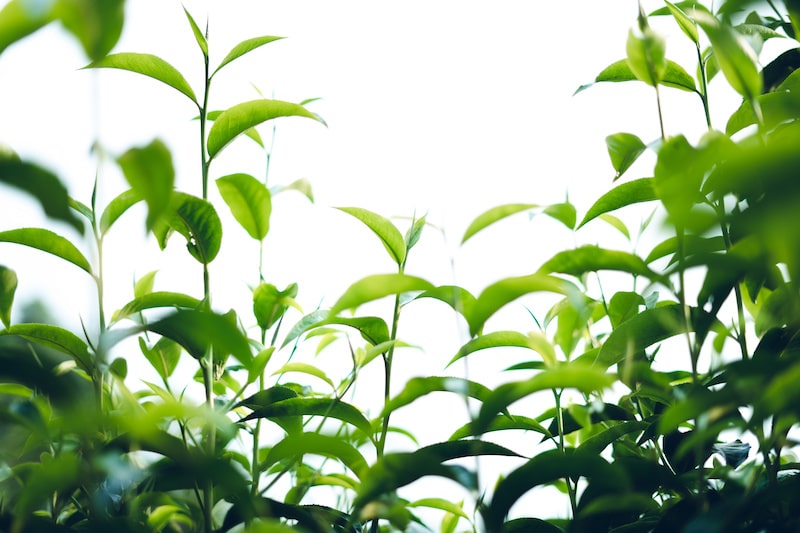Subscribe to Green Tea Podcast:
Can I Grow Tea Plant In My Yard?
The Basics Of Growing Your Own Tea Plants
For people who like to grow their herbs, vegetables, and other produce, one of the most common questions for tea lovers is, whether they can plant tea shrubs at home. The simple answer is yes. Almost any plant can be grown within a comparable natural habitat, and there are parts of the United States that are very conducive to growing tea shrubs. Tea plants can also grow outside of their natural habitats if the same conditions are created at home.
Prime Regions of Growth
When it comes to the traditional tea plant used for Japanese Green Tea, white tea and black tea, these shrubs can be easily grown in the southern United States with the warm year-round climate. While these plants thrive in warmth, tea plants should be grown in partial shade for best results.
For people who live in the northern regions of the country, the tea shrub can be planted in a pot that is portable so it can be brought inside during the colder months. If you have a climate-controlled greenhouse, the plants can stay in the greenhouse year-round and typically do quite well. If you live in the northern colder region and you want to let your tea shrubs grow outside in the warmer months and move them to an indoor greenhouse for the fall and winter seasons, this should work out very well.
Types of Tea Plants
Two different types of tea shrubs make all the traditional tea blends that most consumers are familiar with. The top tea plant used in the United States is the Camellia sinensis plant which is known globally as the primary tea plant for non-herbal tea. This plant is widely grown throughout the Far East and in other warmer agricultural climates. There are two subspecies of this type of tea plant, and each comes from a different part of the Far East. These are the Camellia sinensis var. Sinensis from China and Japan, and Camellia sinensis var. Assamica from Assam, India. Each of these can be purchased in seed packets. These tea shrubs create the "Japanese Green tea", "Chinese Green tea ”, “black tea,” or “white tea” varieties depending on how you process the tea leaves once harvested.
Both the Camellia sinensis var. Sinensis and Camellia sinensis var. Assamica will readily grow in U.S. zones 7-9. While most people think of shrubs as smaller plants, tea shrubs can grow up to 40 feet in height. However, it is not recommended to let them grow tall if they are going to be used for continuous tea harvest. To get the most flavorful teas, your tea plants should be kept at 4 to 6 feet in height. Keeping them from overgrowing is easy and can be accomplished by regular pruning. The tea plant is drought resistant and does well in warmer climates.

The Growth Process
Once the tea shrubs are planted and begin to grow, it is easy to get excited about your first harvest. However, tea agriculturalists agree that it is wise not to start any harvesting of the tea leaves and buds until the shrub grows into a full shrub. As with any shrub, the first couple of years are the most important for growth. This is when the plant needs to retain all its nutrients. Waiting will ensure the plant is healthy enough to start a regular harvest. The recommended amount of time is three years. Once the plant reaches harvest growth levels, there are two primary harvests throughout the year. The first harvest is in the early spring and other in the summer.

The Basics of the Harvest
Once the plant reaches harvest growth levels in the third year, there are two primary harvest periods and one flower harvest. The first harvest typically is done in the early spring, and the other is done in the middle of summer. The first primary harvest that makes the best tea leaves for Japanese Green Tea, traditional white tea, and black tea is in Mid-May to early June. This is when the leaves are their most flavorful and nutrient-dense. The second harvest is typically in early to Mid-July. Later harvests tend to produce less flavor and less quality.
The reason the first harvest is so flavorful and nutrient-dense is because the tea plant stays mostly dormant in the winter months, so growth is nominal. When spring finally arrives, the shrub automatically produces a first growth that is aromatic and filled with a light, delicate flavor and packed with nutrients. The plant will continue to grow after July. However, later season leaves can be bitter, which is not best for making teas such as Japanese Green Tea.
Since there are several harvests, it is essential to try to keep the plant in a constant stage of early growth to assure the best in flavor and quality of each harvest. Regular pruning will ensure the plant does not overgrow. The harvested batch will be small for each plant when they are young. If you are trying to have your tea harvest last for a while, then you should grow at least four or five plants.
At each harvest, you should pick the top two green leaves of each stem and one bud from the flowering part of the plant. While this may seem like a small harvest, it is essential to keep to a basic harvest. This helps the plant stay vital and healthy for each growing season. Allowing the lower leaves to remain intact gives extra strength to the base of the shrub and provides for the very best of the plant to be harvested.
The Little White Flowers of Fall
The fall harvest is usually the prime season when the tea plant has beautiful white, 1 1/2" tea flowers that come into bloom. While the two harvest seasons for tea is spring and summer, the white flower of the plant only arrives in the fall. The fall flowers can be a great addition to boost the spring and summer harvested leaves. If these are correctly dried, they will enhance the natural flavors of the tea and make it a much richer blend.
Get Free Bonus Books

Sign up for free to the Green Tea Club to get advice and exclusive articles about how to choose Japanese Tea, and tips, tricks, and recipes for enjoying Japanese tea.
About the author
Kei Nishida
Author, CEO Dream of Japan
Certification: PMP, BS in Computer Science
Education: Western Washington University
Kei Nishida is a Japanese green tea enthusiast, a writer, and the founder and CEO of Japanese Green Tea Co., a Dream of Japan Company. His passion for introducing America to the tea of his homeland was the catalyst for creating the only company that brings high-quality tea from Arahataen Green Tea Farms to the rest of the world. Learn more about Kei
























